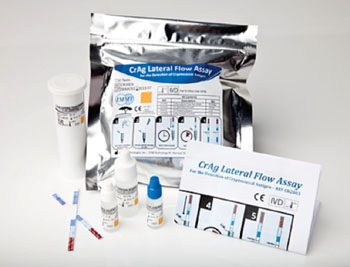Lateral Flow Immunoassay Validated for Detection of Cryptococcal Antigen
By LabMedica International staff writers
Posted on 23 Feb 2015
Cryptococcosis is an important and potentially lethal opportunistic infection in immunocompromised patients, especially in human immunodeficiency virus (HIV) infected and organ transplant patients. Posted on 23 Feb 2015
The incidence of the infection in non-HIV immunocompromised patients caused by Cryptococcus neoformans and in immunocompetent patients caused by C. gattii has increased in developed countries.

Image: The CrAg lateral flow assay to detect cryptococcal antigens (Photo courtesy of Immuno-Mycologics).
Medical microbiologists at the Johns Hopkins University School of Medicine (Baltimore, MD, USA) compared a lateral flow immunoassay (LFA) to a currently used enzyme immunoassay for detection of cryptococcal antigen in 396 sera and 651 cerebrospinal fluid specimens. The cryptococcal antigen detection was performed in retrospective and prospective sera and CSF specimens collected from March 2010 to August 2012 in patients suspected of cryptococcal infection from the Johns Hopkins Hospital, an academic tertiary care hospital.
The newly developed CrAg lateral flow immunoassay (LFA) (Immuno-Mycologics [IMMY]; Norman, OK, USA) offers a rapid and easy alternative detection platform. The LFA assay detects glucuronoxylomannan (GXM), the major polysaccharide component of the cryptococcal capsule. It is a dipstick sandwich immunochromatographic assay that captures the GXM by gold-conjugated anti-Cryptococcus monoclonal antibodies incorporated on the dipstick membrane. This test was compared with an enzyme immunoassay (EIA) from Meridian Premier (Meridian Biosciences; Cincinnati, OH, USA).
The scientists found 97% concordance between the two assays. The LFA assay detected an additional 22 positives. Overall, the LFA had sensitivity of 100% and specificity of 99.6% for the diagnosis of cryptococcosis. Although reading the LFA result can be subjective, they found that the visible lines suggestive of positive results are usually easy to determine. Easy readability combined with additional advantages of rapid turn-around time of 10-minutes ease of performance, requiring little technical expertise, and limited cost make the LFA an attractive tool for routine laboratory use.
The authors concluded that the IMMY LFA showed better sensitivity in detecting C. neoformans antigen in serum and CSF specimens compared to an EIA method in current use. Because of the enhanced sensitivity, users must be aware of the possibility of false positive results in patients with low clinical suspicion of cryptococcal infection. The LFA is rapid, accurate, easy to perform, and cost-effective, and thus it is attractive for implementation by clinical laboratories for routine patient care testing. The study was published on January 31, 2015, in the journal Diagnostic Microbiology and Infectious Disease.
Related Links:
Johns Hopkins University School of Medicine
Immuno-Mycologics
Meridian Biosciences














